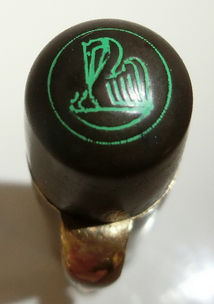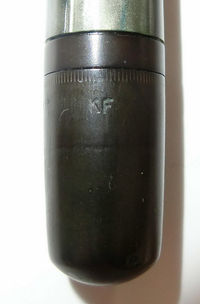top of page
Pelikan 100N (ca.1938) - the second generation
Green indicates the points that differ from Pelikan 100N (ca.1937).
Cap top; material: ebonite, shape: conical, inclined cap top edge, logo: new two chicks logo on the top and “Pelikan D.R.P. Pelikan D.R.P.” on the lateral side.
Cap tube; material: ebonite, shape: 2 cap holes (one hole facing each other), two narrow bands, grooved at the level of vent holes around the inner wall.
Clip; shape: gold plated drop clip.
Nib; material: 14 ct gold, shape: round vent hole, logo:
Pelikan
585
14 KARAT
Feed; material: ebonite, shape: flat tail, three lamellae without the recess.
Nib socket; material: ebonite, shape: 13.5 mm.
Grip section; material: ebonite, shape; inclined top edge, slightly tapered, step near the thread.
Barrel; material: transparent celluloid with brass ring.
Sleeve; material: celluloid.
Filling system; material: ebonite with cork seal, shape: conical, smooth turning knob⁽¹⁾.
Dimensions;
On April 28, 1938, Günter Wagner celebrated the 100th anniversary, and offered model 100N for the domestic market as the part of the celebration. This is the first pen of the 2nd generation. The only major change from the 1st generation was the cap top logo (new two chicks logo)(Fig.4). Please see Fig.8. This catalog tells what Günter Wagner considered were the special features of new Pelikan fountain pen ("Pelican” catalog No.75 (1939)). The corresponding pages are identical to that of Pelikan catalog No.70 (1938).
Soon after the introduction (May 16, 1938), model 100N were fitted with Pd nibs for the domestic market⁽²⁾, as the use of gold was put under control of the government. As gold were still used for the export market, the second generation is basically characterized by the new cap top.
Sometime in this year, the product range was expanded further. Like model 100, the precious metal models or “luxury models” were introduced (Pelikan-guide).
-
100N Gold; 14 carat gold sleeve and cap rings.
-
101N White Gold; white gold filled cap and sleeve.
-
100N Toledo; "pelican" motifs on a gold plated steel sleeve, "pelican head and beak" motif on a clip, and 14 carat gold milled cap rings.
-
101N Gold; 14 carat gold cap and sleeve.
Initially, precious metal models were sold both for the domestics market and export market. But by the end of March 1939, all precious metal models for the domestic market were discontinued (Pelikan Schreibgeräte), and thereafter, only sold for the export market until 1942.
In addition, several variant models were introduced.
-
The white trim; cap top logo and cap imprint inlaid in white paint and/or clip and cap rings in German silver or Alpaca (Pelikan’s 100N Gray Marbled with Nickel Furniture), (1938 Lizard Pelikan 101N).
-
The fluted cap band and clip (Fig.6-2) (Pelikan-collectibles).
-
Pens without clip (Fig.7)⁽³⁾; for ladies who carry it in their handbags and purses. These pens did not have the common ribbon ring often found on women’s pens (Pelikan Pens: History).
Note;⁽¹⁾The pen has nib size specification on the turning knob (Fig.5), not the cone. I'm not sure if the pen was for the domestic market.
⁽²⁾Gold nibs were still available for the export market (Fig.8,9).
⁽³⁾When this model was exactly released is unclear. Presumably in 1938.
100N Gold
Solid 14 carat gold (cap rings and sleeve).

101N White Gold
White gold filled (cap top, cap top tube, and sleeve).

101N Gold
Solid 14 carat gold (cap top, cap top tube, and sleeve).

bottom of page














